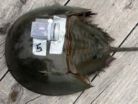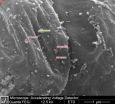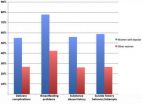(Press-News.org) DURHAM, N.H. – New research from Plymouth State University and the University of New Hampshire indicates that collecting and bleeding horseshoe crabs for biomedical purposes causes short-term changes in their behavior and physiology that could exacerbate the crabs' population decline in parts of the east coast.
Each year, the U.S. biomedical industry harvests the blue blood from almost half a million living horseshoe crabs for use in pharmaceuticals — most notably, a product called Limulus amebocyte lysate (LAL), used to ensure vaccines and medical equipment are free of bacterial contamination. This lifesaving product can only be made from horseshoe crab blood, says researcher Win Watson, UNH professor of zoology.
"The crabs are very heavily bled — about 30 percent or more of their blood is taken, and that's a fair amount," says Chris Chabot, professor of neurobiology at PSU and a co-author on the study. "Approximately 20 to 30 percent of those crabs do not survive, so we were curious if any of the surviving crabs experienced nearly lethal effects from the bleeding," he said.
The study, "Sublethal Behavioral and Physiological Effects of the Biomedical Bleeding Process on the American Horseshoe Crab," was published recently in the journal The Biological Bulletin.
With funding provided by a N.H. Sea Grant development grant, Chabot, Watson and lead author Rebecca Anderson, a PSU graduate student, replicated the biomedical bleeding process to determine the potential impacts on the crabs' behavior.
After capturing the crabs in New Hampshire's Great Bay and transporting some of them back to Chabot's lab at PSU and others to UNH's Jackson Estuarine Laboratory, the researchers monitored their movements for a week and then harvested some of their blood. Electronic data recorders called accelerometers that measure the crabs' speed and direction were strapped to their backs and the crabs were placed in running wheels in tanks filled with seawater.
The researchers found that for approximately two weeks after the bleeding procedure, the crabs' behavior differed from their behavior prior to the bleeding — they moved less frequently and with different patterns and rhythms, indicating they may have been disoriented. The researchers hope to track the movements of bled horseshoe crabs in their native environments to verify that their lab findings apply to real life behavioral changes.
One of the concerns, Anderson explains, is that the crabs are collected for bleeding during their breeding cycle when it's easiest to capture them on beaches. If the crabs are bled and then returned to the beach in a disoriented condition, they might be less likely to breed. This has the potential to exacerbate the population declines that are already occurring in parts of the east coast, including Delaware and Cape Cod. The populations in N.H. seem to be holding steady at the moment.
"If the biomedical industry could delay the blood harvest, it would probably help these animals," Chabot says. "For example, if they are bled after the breeding season, then they could recover in the subsequent months, fatten up and survive the winter without any problems to be able to breed again the following year," he said.
Watson suggests that the conditions under which they are transported could be improved as well. Fishermen capture the horseshoe crabs and often place them on a hot boat deck until they are transported by truck to the biomedical facility, all the while out of water and unable to breathe. If instead they were kept in cold, well-aerated water and perhaps fed, their stress levels might decrease and thus improve their chances of survival and ability to breed upon return to their native habitat.
Watson also notes that it is unclear which part of the process is the most detrimental — the bleeding, the transporting, or simply keeping the crabs in the lab and out of their natural environment. Their research also revealed that the crabs' levels of hemocyanin, a protein in their system that helps transport oxygen in their blood, decreased for all individuals regardless of whether or not they were bled. Lowered hemocyanin levels might lessen the crabs' resilience to the stress of the experience.
Regardless, the researchers feel improvements in the collection and bleeding process are imperative to help preserve the species. In addition to the economic value of their blood, horseshoe crab eggs provide a critical food source for shorebirds that stop in Delaware on their migration to the Arctic. The adult crabs are also harvested for bait in the whelk and eel fisheries in many states, not including New Hampshire.
"We want to ensure that the biomedical bleeding is a sustainable practice, because horseshoe crabs are a critical component of the coastal ecosystem," Chabot says.
"I hope that this research helps to design management regulations that meet the needs of both the people and the crabs," Anderson adds.
INFORMATION:
The University of New Hampshire, founded in 1866, is a world-class public research university with the feel of a New England liberal arts college. A land, sea, and space-grant university, UNH is the state's flagship public institution, enrolling 12,200 undergraduate and 2,300 graduate students.
Photographs available to download:
http://www.unh.edu/news/releases/2014/02/images/running-wheel-8620.jpg
Horseshoe crabs were placed in underwater running wheels to monitor their movement after being bled.
Credit: Chris Chabot, Plymouth State University
http://www.unh.edu/news/releases/2014/02/images/bleeding-procedure-157.jpg
Students bleed a horseshoe crab to replicate the biomedical process used to procure Limulus amebocyte lysate (LAL), a product used to ensure vaccines are free of bacterial contamination.
Credit: Alexandria Sandry, Plymouth State University
http://www.unh.edu/news/releases/2014/02/images/accelerometer-7891.jpg
Horseshoe crabs were fitted with accelerometers to record their movements before and after the bleeding procedure.
Credit: Win Watson, University of New Hampshire
http://www.unh.edu/news/releases/2013/may/hsc.jpg
Mating horseshoe crabs.
Credit: Helen Cheng
Reporters and editors: Chris Chabot is available at chrisc@plymouth.edu or 603.535.2864; Win Watson is available at win@unh.edu or 603.862.1629.
Biomedical bleeding affects horseshoe crab behavior
2014-02-24
ELSE PRESS RELEASES FROM THIS DATE:
Significant discrepancies between FISH and IHC results for ALK testing
2014-02-24
DENVER –The findings of a recent study indicate that routine testing with both fluorescent in situ hybridization (FISH) and immunohistochemistry (IHC) may enhance the detection of ALK-positive non-small cell lung cancer (NSCLC). Accurate determination of ALK-positive tumors is necessary to identify patients with advanced NSCLC who are most likely to benefit from targeted therapy with an ALK inhibitor.
The discovery of ALK rearrangement in about 1% to 7% of NSCLCs led to the development of ALK inhibitors, such as crizotinib, which have significantly improved treatment ...
Researchers find flowing water can slow down bacteria
2014-02-24
In a surprising new finding, researchers have discovered that bacterial movement is impeded in flowing water, enhancing the likelihood that the microbes will attach to surfaces. The new work could have implications for the study of marine ecosystems, and for our understanding of how infections take hold in medical devices.
The findings, the result of microscopic analysis of bacteria inside microfluidic devices, were made by MIT postdoc Roberto Rusconi, former MIT postdoc Jeffrey Guasto (now an assistant professor of mechanical engineering at Tufts University), and Roman ...
Tip to dieters: Beware of friends and late night cravings
2014-02-24
There's more to dieting than just sheer willpower and self-control. The presence of friends, late night cravings or the temptation of alcohol can often simply be too strong to resist. Research led by Heather McKee of the University of Birmingham in the UK monitored the social and environmental factors that make people, who are following weight management programs, cheat. The study¹ is published in the Springer journal Annals of Behavioral Medicine.²
Eighty people who were either part of a weight-loss group or were dieting on their own participated in the one-week study. ...
Novel assay developed for detecting ALK rearrangement in NSCLC
2014-02-24
DENVER – Researchers have developed a novel technique for detecting ALK rearrangements in non-small cell lung cancers (NSCLCs) that is more sensitive and easier to perform than currently available techniques. The technique can help enhance the routine practice of diagnostic ALK testing on NSCLCs, which is crucial for identifying patients with advanced NSCLC who are most likely to benefit from targeted therapy with an ALK inhibitor.
None of the current three routine methods used to detect ALK rearrangements in NSCLC is without drawbacks, especially for tissue specimens ...
A fast and effective mechanism to combat an aggressive cancer
2014-02-24
Ovarian cancer accounts for more deaths of American women than any other cancer of the female reproductive system. According to the American Cancer Society, one in 72 American women will be diagnosed with ovarian cancer, and one in 100 will ultimately die of the condition.
Now Prof. Dan Peer of Tel Aviv University's Department of Cell Research and Immunology has proposed a new strategy to tackle an aggressive subtype of ovarian cancer using a new nanoscale drug-delivery system designed to target specific cancer cells. He and his team – Keren Cohen and Rafi Emmanuel from ...
EARTH Magazine: Tsunamis from the sky
2014-02-24
Alexandria, VA – On a beautiful, clear June morning in 1954, a massive wave suddenly swept out of Lake Michigan killing at least seven people along the Chicago waterfront. At the time, the wave was attributed to a storm that had earlier passed over northern Lake Michigan, but how it came to swamp faraway Chicago, with no warning, was not understood.
The Great Lakes, along with the Mediterranean, Japan and many other parts of the world, have a long history of such waves, which have characteristics similar to tsunamis triggered by earthquakes or landslides.
Only recently, ...
Cardiovascular Institute researcher: Cancer drug may lower sudden cardiac death risk
2014-02-24
PROVIDENCE, R.I. – A researcher at the Cardiovascular Institute (CVI) at Rhode Island, The Miriam and Newport hospitals has found that a new class of drugs, originally developed to treat cancer, reduces sudden cardiac death risk after a heart attack. The findings were published online in advance of print in the Journal of the American College of Cardiology.
"Currently, there are limited options to reduce sudden cardiac death following a heart attack," said principal investigator Samuel C. Dudley, M.D., Ph.D., chief of cardiology at the CVI. "The benefit of most drugs ...
Toxic injection with elastic band
2014-02-24
This news release is available in German.
Bacteria have developed many different ways of smuggling their toxic cargo into cells. Tripartite Tc toxin complexes, which are used by bacteria like the plague pathogen Yersinia pestis and the insect pathogen Photorhabdus luminescens, are particularly unusual. Stefan Raunser from the Max Planck Institute of Molecular Physiology in Dortmund and his colleagues from the University of Freiburg have produced extremely accurate and detailed images of these "toxic injections"; they reveal from where the molecule complexes take ...
Precursor of multiple myeloma more common in blacks than whites, Mayo study finds
2014-02-24
ROCHESTER, Minn. — Feb. 24, 2014 — Blacks may be twice as likely as whites to develop multiple myeloma because they are more likely to have a precursor condition known as monoclonal gammopathy of undetermined significance (MGUS), a Mayo Clinic study has found. Not only is MGUS more common in blacks, but the type seen in the black population is also more apt to have features associated with a higher risk of progression to full-blown multiple myeloma, a cancer of a type of white blood cell in bone marrow.
The findings, which appear in the journal Leukemia, are from the ...
Higher risks among perinatal women with bipolar disorder
2014-02-24
PROVIDENCE, R.I. [Brown University] — Pregnant and postpartum women with bipolar disorder more frequently have significant mental health and early mothering challenges than other perinatal women undergoing psychiatric treatment, according to a study in the Journal of Affective Disorders. The findings indicate the importance of properly identifying the disorder and developing specific treatments for women during and after pregnancy, the lead author said.
"Similar to what you find with bipolar disorder in the nonperinatal population, the overall level of clinical severity ...



